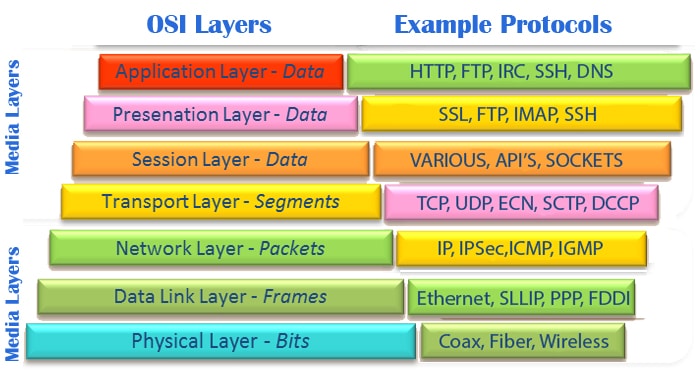


The physical layer has the following major functions:
The OSI Physical layer comprises the enterprise’s physical and site security concerns, which includes all these aspects:
The data link layer provides node-to-node data transfer—a link between two directly connected nodes. It detects and possibly corrects errors that may occur in the physical layer. It, among other things, defines the protocol to establish and terminate a connection between two physically connected devices. It also defines the protocol for flow control between them. Data link layer has two sublayers:
The MAC and LLC layers of IEEE 802 networks such as 802.3 Ethernet, 802.11 Wi-Fi, and 802.15.4 ZigBee, operate at the data link layer. The Point-to-Point Protocol (PPP) is a data link layer that can operate over several different physical layers, such as synchronous and asynchronous serial lines.
Security threats that may occur at this level are the following:
The network layer provides the functional and procedural means of transferring variable length data sequences (called datagrams) from one node to another connected to the same network. It translates logical network address into physical machine address. A network is a medium to which many nodes can be connected, on which every node has an address and which permits nodes connected to it to transfer messages to other nodes connected to it by merely providing the content of a message and the address of the destination node and letting the network find the way to deliver the message to the destination node, possibly routing it through intermediate nodes. If the message is too large to be transmitted from one node to another on the data link layer between those nodes, the network may implement message delivery by splitting the message into several fragments at one node, sending the fragments independently, and reassembling the fragments at another node. It may, but need not, report delivery errors.
The transport layer provides the functional and procedural means of transferring variable-length data sequences from a source to a destination host via one or more networks, while maintaining the quality of service functions.
An example of a transport-layer protocol in the standard Internet stack is Transmission Control Protocol (TCP), usually built on top of the Internet Protocol (IP).
The transport layer controls the reliability of a given link through flow control, segmentation/desegmentation, and error control. Some protocols are state- and connection-oriented. This means that the transport layer can keep track of the segments and retransmit those that fail. The transport layer also provides the acknowledgement of the successful data transmission and sends the next data if no errors occurred. The transport layer creates packets out of the message received from the application layer. Packetizing is a process of dividing the long message into smaller messages.
Although not developed under the OSI Reference Model and not strictly conforming to the OSI definition of the transport layer, the Transmission Control Protocol (TCP) and the User Datagram Protocol (UDP) of the Internet Protocol Suite are commonly categorized as layer-4 protocols within OSI. TCP and UDP occur at the Transport layer.
Security threats that occur at these levels include the following:
In these layers, firewalls and router Access Control Lists (ACLs) can be found.
In the OSI model, Layers 5–7 are known as the Application Set which are:
The session layer controls the dialogues (connections) between computers. It establishes, manages and terminates the connections between the local and remote application. It provides for full-duplex, half-duplex, or simplex operation, and establishes checkpointing, adjournment, termination, and restart procedures. The OSI model made this layer responsible for graceful close of sessions, which is a property of the Transmission Control Protocol, and also for session checkpointing and recovery, which is not usually used in the Internet Protocol Suite. The session layer is commonly implemented explicitly in application environments that use remote procedure calls.
The presentation layer establishes context between application-layer entities, in which the application-layer entities may use different syntax and semantics if the presentation service provides a big mapping between them. If a mapping is available, presentation service data units are encapsulated into session protocol data units, and passed down the protocol stack. This layer provides independence from data representation (e.g., encryption) by translating between application and network formats. The presentation layer transforms data into the form that the application accepts. This layer formats and encrypts data to be sent across a network. It is sometimes called the syntax layer.
Security threats that occur at these layers involve:
The application layer is the OSI layer closest to the end user, which means both the OSI application layer and the user interact directly with the software application. This layer interacts with software applications that implement a communicating component. Such application programs fall outside the scope of the OSI model. Application-layer functions typically include identifying communication partners, determining resource availability, and synchronizing communication. When identifying communication partners, the application layer determines the identity and availability of communication partners for an application with data to transmit. When determining resource availability, the application layer must decide whether sufficient network or the requested communication exists. In synchronizing communication, all communication between applications requires cooperation that is managed by the application layer. This layer supports application and end-user processes. Communication partners are identified, quality of service is identified, user authentication and privacy are considered, and any constraints on data syntax are identified. Everything at this layer is application-specific.
The Application layer supplies services to application procedures that are located outside the OSI layer. It appears that most of the security breaches occur at the Application layer: a survey by Gartner showed 70% of successful attacks occurred at the Application layer. In 2000 the FBI reported that hackers at the Application layer caused over $300 million in damages.
Around 47% of application security flaws fall into these categories: